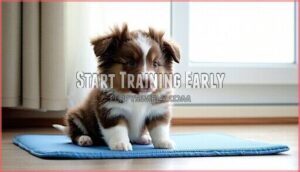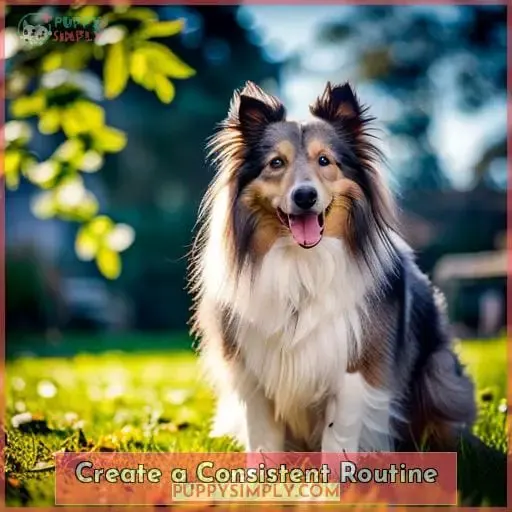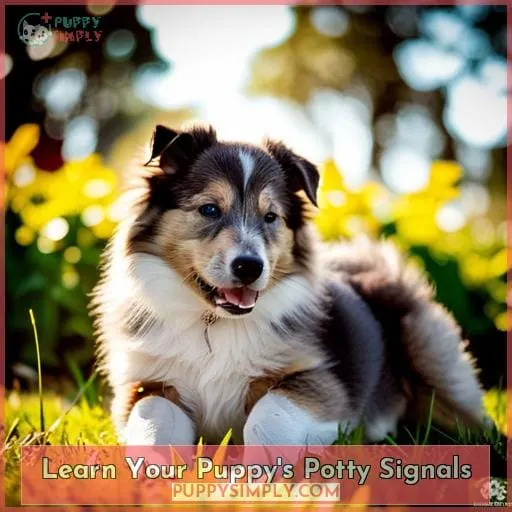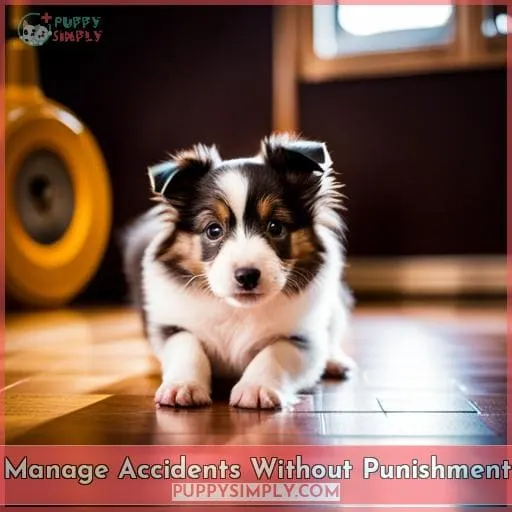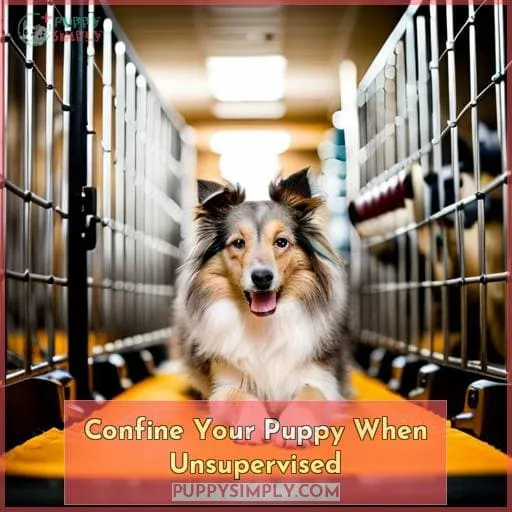This site is supported by our readers. We may earn a commission, at no cost to you, if you purchase through links.
 Leash in hand, take your Sheltie pup outside often.
Leash in hand, take your Sheltie pup outside often.
Consistency and patience lead to success when potty training.
Watch for circling and sniffing – signs they need to go.
Praise immediately after potties.
Limit access until fully trained.
If accidents happen, remain calm and try again later.
Freedom comes gradually.
With time, your Sheltie will learn to potty outside consistently.
Table Of Contents
- Key Takeaways
- Start Training Early
- Be Patient With Your Sheltie Puppy
- Create a Consistent Routine
- Learn Your Puppy’s Potty Signals
- Praise and Reward Successfully Going Potty
- Manage Accidents Without Punishment
- Confine Your Puppy When Unsupervised
- Gradually Increase Freedom
- Use Potty Bells for Communication
- Frequently Asked Questions (FAQs)
- How old should my Sheltie puppy be before I start potty training?
- What cleaning products work best for eliminating odors from potty training accidents?
- Should I use different techniques for potty training a female versus a male Sheltie puppy?
- How can I potty train my Sheltie puppy if I live in an apartment without easy outdoor access?
- What signs indicate my Sheltie puppy is ready to transition from indoor potty training to being fully house trained?
- Conclusion
Key Takeaways
- Start indoor potty training with pads between 8-12 weeks old, then transition to outdoor training at 16 weeks or older.
- Take the puppy outside regularly, especially after meals and naps, and reward successes.
- Be patient and consistent with a routine, praise progress, and calmly manage accidents without scolding.
- Use positive reinforcement like treats and verbal praise to shape desired potty habits over time.
Start Training Early
Potty training should begin as early as possible with Sheltie puppies to instill good habits.
Generally, you can start indoor potty training using pads around 8 weeks of age.
Then, once your puppy reliably uses the pads, you can transition to outdoor potty training at 16 weeks or older.
Indoor Training First
You should start indoor training early with your Sheltie puppy.
Designate a specific indoor area and place training pads there.
Watch your puppy closely for signs they need to eliminate like whining or circling.
When they do, swiftly move them to the pads and praise even small successes.
Leave messes there initially so they associate the smell.
Once they consistently use the pads, about 8 out of 10 times, start introducing them to outdoor training.
Manage accidents calmly without scolding and be patient.
Increase their freedom gradually as they demonstrate reliability.
Incorporating potty bells can help them communicate needs.
Outdoor Training Next
Once you’ve established consistent indoor potty training, it’s time to start the transition outside.
Take your Sheltie puppy into the backyard or designated outdoor area regularly, especially after meals, naps, or play sessions, and reward them enthusiastically when they go potty in the correct spot.
Stay patient through any accidents as they continue learning.
Begin with short, supervised outdoor sessions.
Extend time outside as bladder control develops.
Initially return inside immediately after potty.
Eventually, allow outdoor play time after elimination.
Overcoming common challenges like distracting environments requires patience.
Stick to a consistent outdoor routine while praising and rewarding your puppy’s progress toward reliable potty habits.
Be Patient With Your Sheltie Puppy
Don’t get frustrated if your pup is slow to pick up potty training—it’ll click eventually if you stick to it.
Shelties are intelligent dogs, but potty training still requires patience, especially for young pups.
Maintain realistic expectations about your puppy’s progress.
While some Shelties may quickly pick up potty training, others can take weeks or months to master it.
Puppies as young as 8 weeks old have developing bladder and bowel control. Accidents will happen during this early training phase.
Stay positive through the ups and downs of potty training.
Respond gently when accidents occur instead of scolding your pup. This encourages faster learning while building a strong bond.
Monitor your puppy closely and use positive reinforcement like praise or treats for desired potty behaviors.
Be consistent with your routine.
With an observant, patient approach plus a consistent schedule, your Sheltie will get there.
Patience and positivity are key during those early months!
Create a Consistent Routine
In training your pup, stick to a regular schedule for things like meals, naps, playtime, and potty breaks.
A consistent routine provides many benefits for potty training success, including:
- Helping your puppy learn to hold it for longer periods of time between potty breaks.
- Establishing a predictable bathroom schedule that aligns potty time with your puppy’s biological needs.
- Reinforcing good potty habits.
- Reducing the likelihood of accidents.
Your potty training schedule should include taking your puppy outside frequently, especially first thing in the morning, shortly after meals or naps, and following playtime.
Timely potty breaks will enable your Sheltie pup to relieve themselves in the appropriate place and prevent indoor accidents.
Overall, maintaining consistency and establishing solid potty habits early on through a regular routine can shorten your Sheltie’s potty training duration.
Learn Your Puppy’s Potty Signals
How are you spotting your puppy’s signals that they need to go potty, like sniffing, circling, or pawing at the door?
An early start to potty training along with a consistent routine will help you recognize these common signs that your Sheltie puppy needs to relieve themselves:
| Signal | Description | Response |
|---|---|---|
| Sniffing | Your puppy begins sniffing the floor intensively | Promptly take them outside to their potty spot |
| Circling | Your puppy starts turning around in circles while sniffing | Quickly lead them to the outdoors to prevent accidents |
| Pawing | Your puppy paws at the door or scratches the floor | Immediately let them outside to do their business |
When you notice these signals, positively reinforce your puppy’s communication by praising them and giving a reward like a treat or playtime.
Paying close attention and responding right away helps reinforce the cue that they need to potty outside.
Consistency builds trust in the routine so your Sheltie puppy will learn to hold it until they can properly relieve themselves in their designated spot.
Praise and Reward Successfully Going Potty
You’ll want to enthusiastically praise and reward your puppy immediately after she successfully goes potty in the designated area to reinforce the behavior.
Timely positive reinforcement is key for potty training success.
When your Sheltie pup finishes eliminating in her approved potty spot, excitedly praise her with an enthusiastic Good girl! right away.
Consider pairing verbal praise with a high-value treat to make going potty an extremely positive experience.
Keep rewarding every time to maintain your pup’s motivation.
Be patient, as this reinforcement technique consistently applied will instill good potty habits.
With persistence, your Sheltie will learn that pottying in the right place leads to endless praise and rewards.
Eventually, you can phase out food treats while still verbally praising.
Consistent, timely rewards encourage the wanted potty training behavior.
Manage Accidents Without Punishment
Punishment-free accident management lets you refocus your frustrated pup toward their potty spot when mishaps occur.
Redirect your Sheltie’s behavior gently without scolding or punishment.
This positive, reward-based approach encourages faster learning while building trust.
If accidents happen during potty training, calmly interrupt the behavior and guide your puppy outside or to their designated indoor area to finish.
Then, immediately praise and offer a treat once they complete going potty in the proper spot.
With this positive correction method instead of punishment, your Sheltie will come to associate accidents with redirection rather than fear.
Stay patient – their tiny bladders are still developing control.
Consistency builds habits, so celebrate small wins on your path toward leash walking a confident, potty-trained Sheltie.
Confine Your Puppy When Unsupervised
To ensure successful potty training, confine your Shetland Sheepdog puppy when you’re unable to supervise them closely.
Use crates, playpens, or designated indoor areas to restrict access. This teaches them control by limiting space and prompts communication when they need to go.
Introduce crate training early, making it a safe, comfortable area with toys and bedding. Confine for short intervals, then increasingly longer periods. Never use the crate solely for punishment.
Alternatively, block access to rooms using baby gates and keep doors closed. Place potty training pads, beds, and toys in the accessible area.
The more confined the space is initially, the more likely your puppy will learn to hold it or signal when nature calls instead of sneaking off to have an accident out of view.
Supervised confinement instills good habits.
Gradually Increase Freedom
As your puppy becomes more reliable with their potty habits over time, you’d incrementally expand their access throughout your home.
Start by allowing supervised access to only one additional room at a time. Pay close attention to their signals and behaviors, praising for going potty in the right spot and redirecting accidents.
Once your Sheltie puppy has mastered that space with no accidents for a week straight, allow access to the next room.
Continue gradually until they’ve learned bladder and bowel control throughout your entire home.
Freedom privileges must be earned based on demonstrated training progress and self-control.
With patience, your Sheltie will gain the independence to eventually have full house access and spend time outdoors unattended – a major freedom milestone!
Use Potty Bells for Communication
Having gradually increased your puppy’s freedom, you’re using potty bells for enabling them to communicate their potty needs.
Installing potty bells can facilitate successful potty training by:
- Establishing a clear signal for your Sheltie puppy to convey when they need to go outside.
- Enabling you to respond swiftly to your puppy’s potty cues instead of waiting for more obvious signs like circling or sniffing which may come too late.
- Reinforcing the habit of going potty outdoors. When the puppy rings the bell and is rewarded with access outside, it cements the association.
Routine bell use, attentive responses, and positive rewards help puppies communicate their needs for timely potty breaks.
An early start with potty bells builds this important foundation.
Frequently Asked Questions (FAQs)
How old should my Sheltie puppy be before I start potty training?
Begin Sheltie potty training at 8-12 weeks old to positively reinforce good habits while their minds are impressionable.
Start too late, and they may develop undesirable behaviors that must be unlearned.
However, don’t rush training if your pup isn’t developmentally ready.
Watch for signs they can control their bladder and bowels.
What cleaning products work best for eliminating odors from potty training accidents?
Vinegar neutralizes odors best. A solution of one part vinegar to one part water effectively eliminates accidents’ smells.
Dilution concentration is important; using straight vinegar may be too harsh.
Should I use different techniques for potty training a female versus a male Sheltie puppy?
No, the same potty training techniques should work for both male and female Sheltie puppies.
Consistency and patience are key regardless of gender.
How can I potty train my Sheltie puppy if I live in an apartment without easy outdoor access?
Try an indoor grass patch.
Teach pup that’s the only place for business.
Reward successes.
Leash walk to it often at first.
Increase freedom slowly as reliably improves.
Don’t punish accidents – gently redirect instead.
Patience & consistency are key.
What signs indicate my Sheltie puppy is ready to transition from indoor potty training to being fully house trained?
When your Sheltie consistently seeks you out to be taken outside,
communicates their need through signals like whining or pawing at the door,
and has mostly error-free potty sessions outdoors,
they’re likely ready to be fully house trained without indoor pads.
Conclusion
Have you set realistic expectations for how long potty training your Sheltie will take?
With diligent supervision, routine, and positive reinforcement, your puppy will likely be accident-free within 3-6 months.
Remember that freedom comes gradually as your Sheltie learns to potty outside consistently.
Stick to the training plan, and soon you’ll have a happy, house-trained companion by your side.

